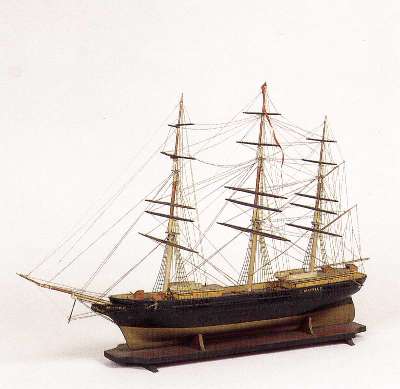Palmer List of Merchant Vessels

|
S. C. TWING (1855)
MOBILE [1856]
Model, in glass case, of Bremen ship MOBILE ex
S. C. TWING (U.S.). 69,5 x 8,7 x 38,5 cm (length x width x height).
Focke-Museum, Bremen,
Inv.-Nr. 76.445, acquired in 1976 from Scheessel. Source: Johannes Lachs,
Schiffe aus Bremen; Bilder und Modelle im Focke-Museum (Bremen: H.
M. Hauschild, [1994]), p. 137, no. 110. To request a copy of this picture,
contact the Focke-Museum.
|
The U.S. ship S. C. TWING was built at Portsmouth, New
Hampshire, in 1855. 1177 net register tons. I know nothing of her
early career, except that on one of her earliest voyages, the
S. C. TWING stranded off Göteborg, Sweden.
In 1856, the S. C. TWING was purchased for 88,000 Taler by the
Bremen firm of D. H. Wätjen, who renamed her MOBILE,
and placed her in the North American trade. At 1290 Lasten/1856 tons,
the MOBILE became at the time of her purchase the largest
sailing vessel in the Bremen merchant fleet. She was destroyed by
fire at Mobile, Alabama, in January 1867. The following is an account
of her destruction, printed in the New York Herald for 28
January 1867, and taken in turn from the Mobile Advertiser
of 19 January 1867:
At about 12 o'clock on Thursday night last [17/18 January 1867] flames
were discovered issuing from the fore hatch of the Bremen ship
MOBILE, then at anchor in the lower bay, some 30 miles below
the city. Capt. Lee, of the steamer JACKSON, was alongside of
the ship PROGRESS, with a load of cotton, and as soon as he was
informed of the fire immediately cast off and stood for the burning
ship. The wind was blowing fresh from the north at the time, and it
was impossible for Capt. Lee to get to leeward of the MOBILE
without running great risk of losing his own boat and cargo, but he
took his vessel to windward and ahead of the MOBILE, and made
a successful effort to bring a stream of water from the pumps of his
steamer to bear upon the fire; a hawser was got out from the bow of
the M[OBILE] to the JACKSON, up which Mr. Jessup, of
the latter vessel, gallantly made his way and led the hose from the
steamer to the fore hatch of the ship. The flames had made such headway,
however, that the intense heat prevented anything more being done than
lying by to pick up any one who might chance be compelled to jump
overboard. Fortunately for the mate and the three men who had so
courageously remained at their posts, the boats of the Br[itish] ship
TUDOR, under charge of Capt. Wherland, pulled under the counter
of the burning ship and rescued them from their dangerous position.
With the exception of the ship's chronometer and two quadrants the
captain and officers lost all their clothing and personal effects
saving only the clothes they stood in. The M[OBILE] was a
vessel of abut 5,000 bales capacity, and an excellent ship in every
particular. She was owned in Bremen and sailed under that flag, but
was American built, being one of the numerous vessels placed under
foreign colors during the war. She was under charter for Liverpool
and was about half loaded, having 2,350 bales of cotton aboard.
Rumor has it that the ship was fuly insured, and we understand from
a gentleman in a position to know that the cotton is fully covered
by the policies of foreign offices. The fire was undoubtedly the work
of an incendiary, as no smoking is ever allowed in the 'tween decks
of a vessel loading with cotton. There is as yet no suspicion as to
who the scoundrel is that could thus peril so many lives and destroy
so much property.
Sources: Otto Höver, Von der Galiot zum
Fünfmaster; Unsere Segelschiffe (Bremen: Angelsachsen Verlag,
1934), pp. 277f;
Rolf Reinemuth, Segel aus Downeast; Die
unerschrockenen Männer von der Weser und ihre prächtigen
Schiffe aus Neu-England (Herford: Koehler, 1971), p. 40;
Hans Wätjen, Weisses W im blauen Feld (Wolfsburg 1983),
pp. 116f; Johannes Lachs, Schiffe aus Bremen; Bilder und Modelle
im Focke-Museum (Bremen: H. M. Hauschild, [1994]), p. 137, no.
110.
[17 Feb 1998]
U.S. steamship S. V. LUCKENBACH [1906] -
See: BRITISH QUEEN (1880)
